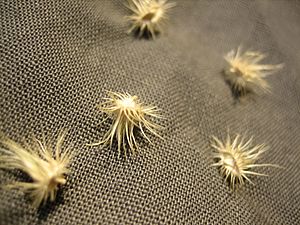Cenchrus biflorus facts for kids
Quick facts for kids Cenchrus biflorus |
|
|---|---|
 |
|
 |
|
| Scientific classification | |
| Genus: |
Cenchrus
|
| Species: |
biflorus
|
| Synonyms | |
|
Cenchrus catharticus |
|
Cenchrus biflorus is a type of annual grass that grows for just one year. It belongs to the Poaceae family, which includes many common grasses. This plant has many different names around the world! In India, people call it Bhurat or Bhurut. In Sudan, it's known as Haskaneet. People in Mauritania use the name Aneeti, while in Nigeria, it's called K 'arangiya (in Hausa) or Ngibbi (in Kanuri). In countries like Senegal and Mali, it's often called "cram-cram".
What is Cenchrus biflorus?
Cenchrus biflorus is a grass that can grow to different heights, from about 4 cm (like a small toy car) up to 90 cm (almost as tall as a 12-year-old!). Its seeds are found inside prickly parts called burs. These burs are quite clever at traveling! They have tiny hooks that easily stick to passing cars, animals, and even your clothes. This helps the plant spread its seeds far and wide.
Sometimes, these burs can be a problem for animals. If they get stuck in an animal's fur or skin, they can cause irritation. If an animal tries to eat the plant, the burs might even cause sores in their mouth.
Where Does Cenchrus biflorus Grow?
This grass is very common in the Sahel region of Africa. The Sahel is a dry area just south of the huge Sahara desert. In fact, some scientists say that where Cenchrus biflorus stops growing, that's where the Sahara desert truly begins!
You can also find Cenchrus biflorus growing in India. Here, people in the Rajasthan region use its seeds to make a special kind of bread. They might use only these seeds or mix them with bajra, another type of grain.
How is Cenchrus biflorus Used?
Cenchrus biflorus is a traditional food plant in parts of Africa. Even though it's not very well-known globally, it has the potential to be a really important food source. It can help improve nutrition, make sure people have enough food, and support farming in dry areas. Because of this, it's sometimes called a "famine food" in desert regions, meaning it's eaten when other foods are scarce.
Besides being a food for people, Cenchrus biflorus is also a valuable plant for feeding animals. Animals like cows and goats, called ruminants, enjoy eating it, especially when the plant is young.

